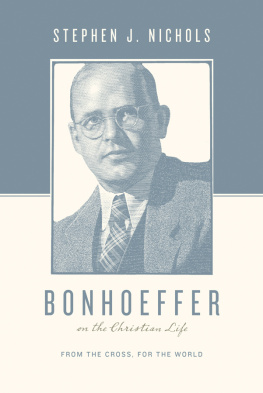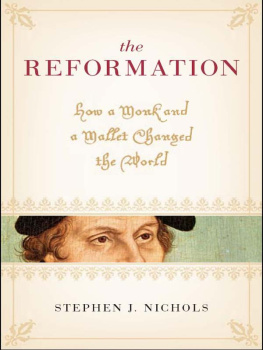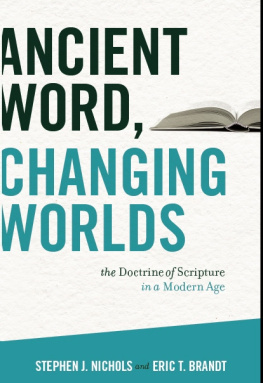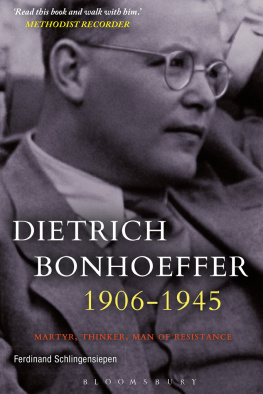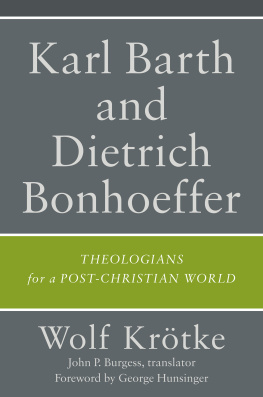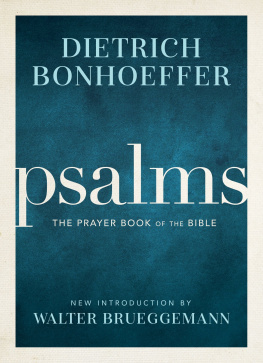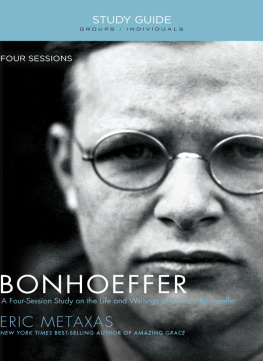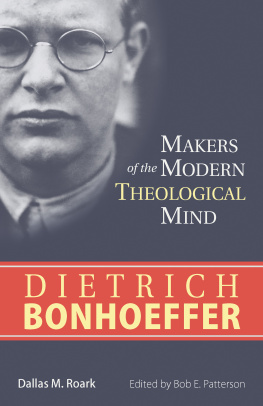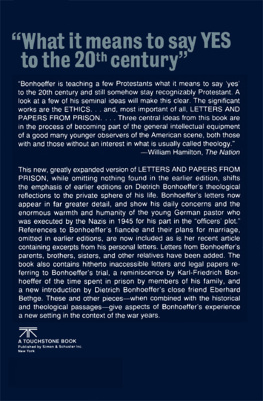Bonhoeffer on the Christian Life: From the Cross, for the World
Copyright 2013 by Stephen J. Nichols
Published by Crossway
1300 Crescent Street
Wheaton, Illinois 60187
All rights reserved. No part of this publication may be reproduced, stored in a retrieval system, or transmitted in any form by any means, electronic, mechanical, photocopy, recording, or otherwise, without the prior permission of the publisher, except as provided for by USA copyright law.
Cover design: Josh Dennis
Cover image: Richard Solomon Artists, Mark Summers
First printing 2013
Printed in the United States of America
The authors Scripture quotations are from the ESV Bible (The Holy Bible, English Standard Version), copyright 2001 by Crossway. 2011 Text Edition. Used by permission. All rights reserved.
Scripture marked KJV is from the King James Version of the Bible.
Trade paperback ISBN: 978-1-4335-1188-2
Mobipocket ISBN: 978-1-4335-1190-5
PDF ISBN: 978-1-4335-1189-2
ePub ISBN: 978-1-4335-2398-4
Library of Congress Cataloging-in-Publication Data
Nichols, Stephen J., 1970
Bonhoeffer on the Christian life : from the cross, for the world / Stephen J. Nichols.
pages cm. (Theologians on the Christian life)
Includes bibliographical references and index.
ISBN 978-1-4335-1188-2 (tp)
1. Bonhoeffer, Dietrich, 19061945. I. Title.
BX4827.B57N525 2013
| 230'.044092dc23 | 2013000954 |
Crossway is a publishing ministry of Good News Publishers.
SH 23 22 21 20 19 18 17 16 15 14 13
15 14 13 12 11 10 9 8 7 6 5 4 3 2 1
CONTENTS
CHAPTER 1
I believe that nothing meaningless has happened to me and also that it is good for us when things run counter to our desires. I see a purpose in my present existence and only hope that I fulfill it.
DIETRICH BONHOEFFER 1
On a hot summers day in July 1939, Dietrich Bonhoeffer stepped off the steamship Bremen and onto the docks of New York Citys harbor. The harbor was busy that year. New York City was playing host to the Worlds Fair, an event altogether eclipsed by the tensions of the pending world war. By September, a United States Navy fleet had moved in to protect the harbor, and mines had been placed along the coast in fear of a German submarine attack. Bonhoeffer knew all too well the tension. He had lived with much worse for some time and was now on his way to America to escape.
Bonhoeffer had been to the United States before. His first trip had come nine years earlier. Already with a doctorate in hand, Bonhoeffer thought he might benefit from studying American theological developments firsthand before settling in to his faculty position at Berlin. So off he went to spend a year at Union Seminary in New York. During that first stay, he had forged deep friendships. One of those friends, Reinhold Niebuhr of Unions faculty, now led the way in arranging for Bonhoeffers second trip to America. Niebuhr hurriedly posted letters to his academic colleagues throughout America to cobble together a lecture tour for Bonhoeffer, in part to fund his stay and in part to shake out a more substantial and permanent teaching offer. At thirty-three years of age and with an impressive list of accomplishments already, Bonhoeffer had a bright career ahead of him.
Bonhoeffer, though, would elude Niebuhrs efforts. The moment Bonhoeffer stepped off the ship, he knew that he had made a mistake. He belonged back in Germany. His diary bears the record, The decision has been made.
Bonhoeffer anticipated that Germany would survive the war. He also realized that the German church, like the nation itself, would need to be rebuilt. After all, how could he play a role in rebuilding the church if he abandoned it during its hour of deepest need? No, he could not stay in America.
Writing to Lehmann, Niebuhr could only say of Bonhoeffers decision, I do not understand it all. Who can understand Bonhoeffers decision? What kind of person would be more at ease in facing down a totalitarian regime on the brink of destruction than conducting a college lecture tour in a free and democratic society an ocean away from the tumult and wreckage of war? Whats more, this was no isolated decision, no adrenaline-charged heroism. Dietrich Bonhoeffers willingness to return to Germany, his willingness to face Hitler and the Nazi regime, ultimately his willingness to die, all stemmed from a deeply honed reflex. He could no more walk away from Germany in 1939when he had opportunity to do sothan you or I can stop our hearts from beating. To understand Bonhoeffers decision in the dog days of a New York summer of 1939, you need to understand Bonhoeffer.
We should not take this episode as evidence of Bonhoeffers heroism. The impulse is understandable, even tempting, but would be a misunderstanding. The letters and his diary point in an entirely different direction. This was no act of blazoned courage. Rather, his decision reveals a brash faith. See him as humble, not heroic. See him as dependent upon God. As he writes in his diary, God certainly sees how much personal concern, how much fear is contained in todays decision, as courageous as it may appear.... At the end of the day, I can only pray that God may hold merciful judgment over this day and all decisions. It is now in Gods hands.
To understand Bonhoeffer, we must understand, on the one hand, the limits of oneself and, on the other hand, the utter absence of limits of God. Bonhoeffer saw himself as limited in his understanding, limited in his experience, limited in his resolve, limited in his strength. To trust in himself would be purelyand merelysanctimony, the religion of Pharisees. But to trust in God would be altogether different. To understand Bonhoeffer, we must first and foremost understand living by faith.
Dietrich Bonhoeffer once wrote that to live by faith (he would say to live truly) means living unreservedly in lifes duties, problems, successes and failures, experiences and perplexities. Bonhoeffer also wrote persuasively of how this Christ-centered or Christ-reality living is the life together, the life of community, centered on our common union with Christ. No, we are not individual heroes achieving greatnessan unfortunate but prevalent model of living the Christian life in our day. Instead, we live together in Christ by faith.
Understanding Bonhoeffer, however, entails more than seeing this life of faith in Christ theologically. It also involves seeing how this theological center manifests itself in his life, in his daily comings and goings. Bonhoeffer was a theologian and a churchman, but he was also a person.
Bonhoeffer wrote poems, for example:
Distant or near,
in joy or in sorrow,
each in the other
sees his true helper
to brotherly freedom.
He tried his hand at a novel. He had a twin sister. He was, for a time, a youth pastor who could play the guitar. He frequented the theater, knew his way around an art gallery. He had opinions on art, music, and architecture. Youre quite right, he wrote from his prison cell, about the rarity of landscape painting in the South generally. Is the south of France an exceptionand Gauguin? He was a professor of theology at the University of Berlin. He took on a rather rough band of youth on a different side of the tracks from which he had come of age. He prepared them for their first communion and, when the time had come for it, bought them all new suits for the occasion.

